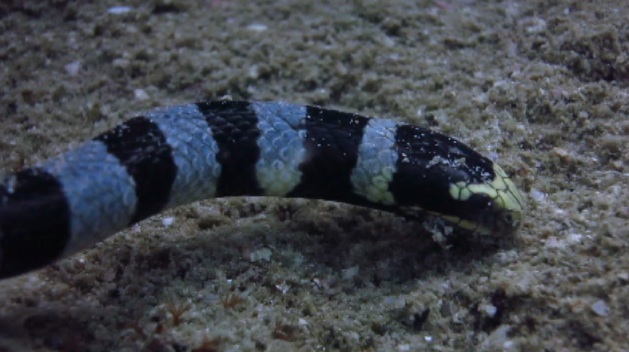Recently, at Twins dive site, I encountered the beautiful banded sea krait. Also known as the colubrine sea krait or yellow-lipped sea krait (Laticauda colubrina), this sea snake is found in tropical Indo-Pacific oceanic waters and frequently spotted around Koh Tao dive sites. Banded sea kraits are one of the most venomous creatures in the world, but they are not aggressive towards divers. They are often seen in the company of giant trevally and goatfish, using a mutualistic relationship with these fish to hunt prey. This technique is quite similar to that of the moray eel, who often team up with groupers to hunt.
Kraits require fresh drinking water and regularly go onto land to digest, mate, and lay eggs. They are capable of spending up to ten days at a time on land. They also frequently swim all the way from the bottom to the surface of the water, and if you can catch and document them in this moment, slowly gliding, twisting, slithering in open blue water, the footage can be incredibly gratifying. Exposure can be tricky, however, as it is difficult for the camera to transition from open blue water onto the aggressively lit surface. But, by understanding the behavioral traits of the banded sea krait, I can anticipate the shot that I am going to take and prepare for its trajectory. When I am fortunate enough to capture a banded sea krait swimming from the surface of the water back down on to the dive site, I often like to use this as a visual parallel to the descent of the students. I will often use the shot directly before or after the divers have begun their descent. Not only is it an engaging metaphor with the divers as they themselves descend down to eighteen meters below the sea, but the movement of this stunning creature, it's tranquil, spiraling movements underwater immediately enrapture my viewers and get them excited for the portion of the video that takes place underwater. For most students, this is the first time that they will see themselves diving underwater, and I try to visually reflect the excitement of this moment as we sink beneath the surface.
Unfortunately, yesterday, the krait I encountered at Twins was very lethargic and un-engaging. A bit of a control freak (or maybe more than a bit....) I am often frustrated by my lack of control over the wildlife and students I film. While I love filming documentary footage, it is important to understand it's limitations. Once I recognize this lack of control, I problem-solve and make the most of the situation I am and as myself, "How can I make this the best shot that it can be?" So, yesterday, while I would have loved to capture the banded sea krait swimming, I had to accept that he was a sleepy snake and instead chose to use Macro settings and a close-up shot to showcase its gorgeously intricate facial patterning. As you can see in this still I have taken from my footage yesterday, the banded sea krait has a distinctive yellow snout and thin black bands in uniform width, which cover the full length of the snake.





